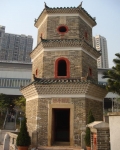Ping Shan Heritage Trail
Archaeology »
Archaeological Monuments » Ping Shan Heritage Trail
Ping Shan Heritage Trail -
Ping Shan Heritage Trail is located in Yuen Long District.
Ping Shan Heritage Trail monument was established on 1993.
Primary threats to Ping Shan Heritage Trail :
The Pagoda was built by Tang Yin-tung, the seventh generation ancestor, more than 600 years ago according to the genealogy of the Tang clan of Ping Shan. Oral history indicates the pagoda was originally a five-storey hexagonal-shaped green-brick structure, but was damaged due to strong weather.
Historical facts of Ping Shan Heritage Trail :
- The Ping Shan Heritage Trail is a fascinating historical journey that takes visitors through the rich heritage of Ping Shan, a district in Hong Kong. Spanning across 1.6 kilometers, this trail showcases an array of historical sites, ancestral halls, temples, and architectural treasures that provide a glimpse into the region's cultural and historical significance. Here are some historical facts about the Ping Shan Heritage Trail:
- Ancient Roots : The Ping Shan area has a history that dates back over 800 years. It was originally settled by the Tang Clan, one of the Five Great Clans of the New Territories in Hong Kong. The Tang Clan played a vital role in the development of the area and had a significant influence on the region's culture and traditions.
- Tang Ancestral Hall : The trail begins at the Tang Ancestral Hall, a key highlight of the heritage trail. Built in the early 16th century, this ancestral hall served as a place for ancestral worship and communal activities for the Tang Clan. It is an excellent example of traditional Chinese architecture and features intricate wood carvings and decorative motifs.
- Yu Kiu Ancestral Hall : Another notable stop on the trail is the Yu Kiu Ancestral Hall. Constructed in the late 16th century, it served as a gathering place for the Yu Clan, another prominent family in the region. The hall is known for its magnificent architecture, including ornate roof decorations and beautiful ceramic figurines.
- Sheung Cheung Wai : As visitors continue along the trail, they come across Sheung Cheung Wai, a walled village that provides insight into the defensive structures of the past. Built around 200 years ago, the village was designed to protect its inhabitants from bandits and pirates. The fortified walls, watchtowers, and gates of Sheung Cheung Wai demonstrate the importance of security during that era.
- Tsui Sing Lau Pagoda : One of the most iconic landmarks along the heritage trail is the Tsui Sing Lau Pagoda. Believed to be the oldest pagoda in Hong Kong, it dates back to the 15th century. The pagoda is a three-tiered structure, and its design reflects the influence of both Chinese and Islamic architectural styles.
- ?Ching Shu Hin : Located near the end of the trail, Ching Shu Hin is a two-story Qing Dynasty building that once served as a school. It was established in the early 20th century by the Tang Clan to provide education to the local community. Today, it houses an exhibition that showcases the history and culture of the Ping Shan area.
- Temples : Along the trail, visitors can also explore several temples that hold religious and cultural significance. These include the Ching Shu Hin Choi Shu Yeung Wong Temple, where the deities of the earth and agriculture are worshipped, and the Yeung Hau Temple, dedicated to the deity of the sea.
- The Ping Shan Heritage Trail offers a unique opportunity to delve into the history and cultural heritage of Ping Shan. It allows visitors to appreciate the architectural beauty of ancestral halls, experience the tranquil ambiance of temples, and gain insights into the daily lives of the clans and communities that have shaped the region over centuries. Whether you are a history enthusiast or simply interested in exploring the heritage of Hong Kong, the Ping Shan Heritage Trail is a captivating journey through time.

